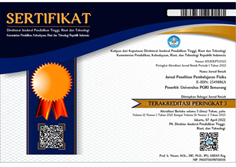Focus and Scope
Jurnal Penelitian Pembelajaran Fisika contains research results of physics learning, both in school and in Higher Education
Section Policies
Articles
Peer Review Process
Papers submitted for publication in the Jurnal Penelitian Pembelajaran Fisika (JP2F) must be the result of research that has never been published and is not in the process of publication or seminar. Similarly, once a paper is published in Jurnal Penelitian Pembelajaran Fisika, it is not allowed to be republished in Indonesian or other languages, except with official permission from the editor of Jurnal Penelitian Pembelajaran Fisika.
Whether or not a paper is accepted is an inviolable editorial decision. Authors will receive the results of the editorial evaluation in no more than six weeks.
Open Access Policy
This journal provides immediate open access to its content on the principle that making research freely available to the public supports a greater global exchange of knowledge.








